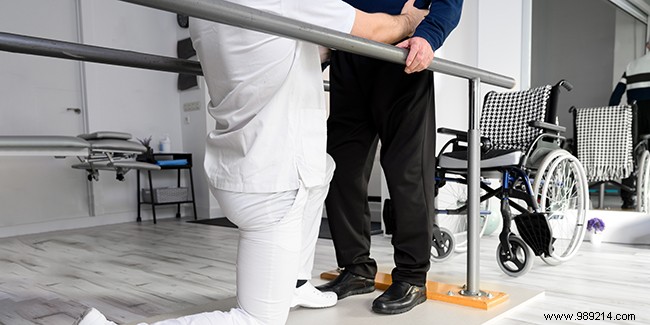
When a stroke occurs, it is always a medical emergency. The stroke has indeed harmful consequences on the brain, the command center of our physical and intellectual abilities. It is therefore necessary to act quickly to avoid the impacts of this pathology as much as possible. The sequelae of a stroke can be very significant and handicap a patient temporarily or for life, as well as being more moderate. Following a stroke, current medical care aims to allow patients to live as normally as possible, thanks in particular to rehabilitation sessions. Patients themselves must also most often change their lifestyle.
A stroke is caused when blood flow to the brain suddenly stops due to a blood clot or a clogged artery. When it occurs, a stroke is a medical emergency because it results in the damage or death of brain cells. The faster the stroke victim is taken care of by medical services, the less serious the sequelae resulting from it.
The brain being the basis of our intellectual, linguistic, motor and affective faculties, we immediately sense what the negative consequences of a stroke can be.
Among the nearly 150,000 people who suffer a stroke each year in France, 30,000 die. For others, the sequelae vary greatly from one individual to another. First according to the type of stroke they suffered, an ischemic stroke (or cerebral infarction), the most common (85% of cases), or a hemorrhagic stroke, then according to the part of their brain that was affected, the extent of the damage caused, the duration of the interruption of blood supply to the brain, and the time between the onset of the stroke and the medical treatment.
Thus, depending on the person and the circumstances, the sequelae of a stroke can be weak, moderate or severe, as transient or permanent for life. According to the National Institute of Health and Medical Research (Inserm), among stroke victims, "about two thirds recover functional independence and three quarters can resume a professional activity".
Among the most serious and disabling sequelae after a stroke are hemiplegia and aphasia.
Hemiplegia is a paralysis that affects one half of the body, with the consequence for those affected of no longer being able to walk normally, of no longer having control of the motor skills of one of their arms or their legs.
Aphasia refers to the total or partial loss of the ability to speak or understand language, whether written or spoken. It can also manifest itself by an automatic repetition of words. In all cases, aphasia affects the daily life of those who suffer from it. It is indeed difficult for them to converse with third parties, to telephone, to watch television, to write, to read, etc.
The sequelae of a stroke can also be almost invisible, in any case not be perceptible in appearance. But, they are no less disabling for the patient who suffers from them because it can be intense fatigue, trouble concentrating, anxiety, or even irritability.
Note:30% of stroke victims suffer from depression within a year of their stroke.
Following a stroke, and as soon as the patient's condition allows it, it is very important to begin rehabilitation as soon as possible. Often a long journey for the sick, especially for the oldest among them.
This rehabilitation can first be motor. In particular, it avoids the occurrence of complications, especially if the limbs of the stroke victim remain paralyzed.
Starting a rehabilitation process very quickly allows stroke victims who experience motor sequelae to regain maximum autonomy, relearn how to walk, learn to use their disabled hand, etc.
For people who have suffered a stroke and have become aphasic, rehabilitation, this time speech therapy, allows them to recover part of their speech or eliminate the speech tics they may be suffering from. It is estimated that one third of stroke victims recover their faculties sufficiently and can then communicate again almost normally.
In all cases, rehabilitation, whether motor or speech therapy, is intended to restore a certain autonomy to the patients and to teach them to live with their possible permanent handicap in the most normal way possible. Some of them have to relearn how to carry out the gestures of daily life such as washing, dressing, preparing meals, driving a car, etc. At this stage, the health professional who intervenes to help people who have had a stroke with significant sequelae is the occupational therapist.
People who have had a stroke are more likely to have another stroke or another cardiovascular disease. This is why these patients must change their lifestyle, especially in terms of eating habits to avoid overweight and obesity in particular. Physical activity, such as quitting smoking, should also be promoted.
People affected by a stroke also need to be much more vigilant when it comes to their health. They must regularly monitor their cholesterol and diabetes levels, their blood pressure, indicators of risk of having a new stroke.